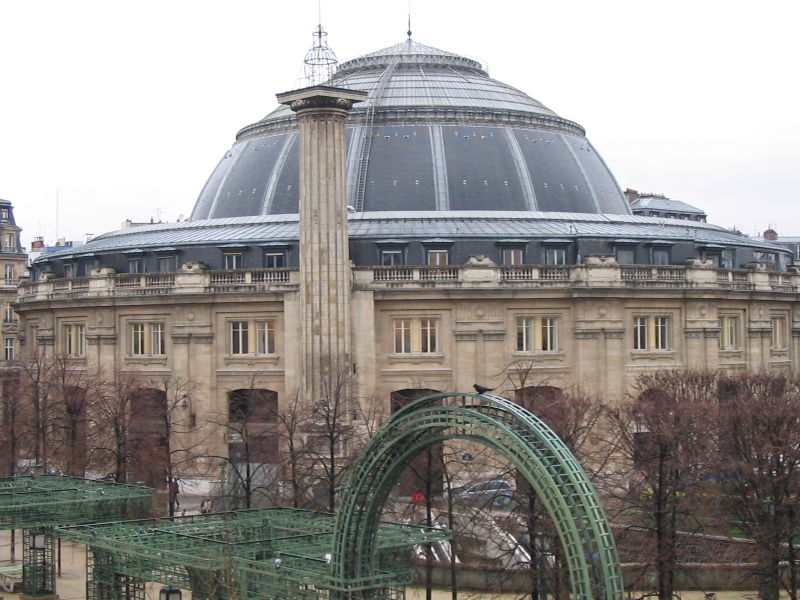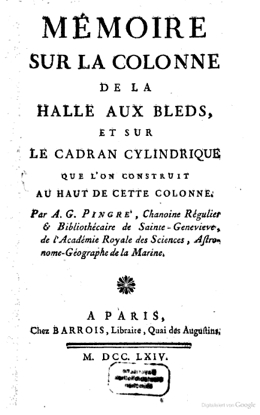|
|
GeoAstro Applets |
Astronomy |
Chaos Game |
Java |
Miscel- laneous |
Pingré
Sundial Applet
|
|
Enter latitude in decimal degrees and press return key, |
|
|
you may use the keys "h", "d", "m", "n"
to increase the hour, date, month, or minute Click
the applet first !
|
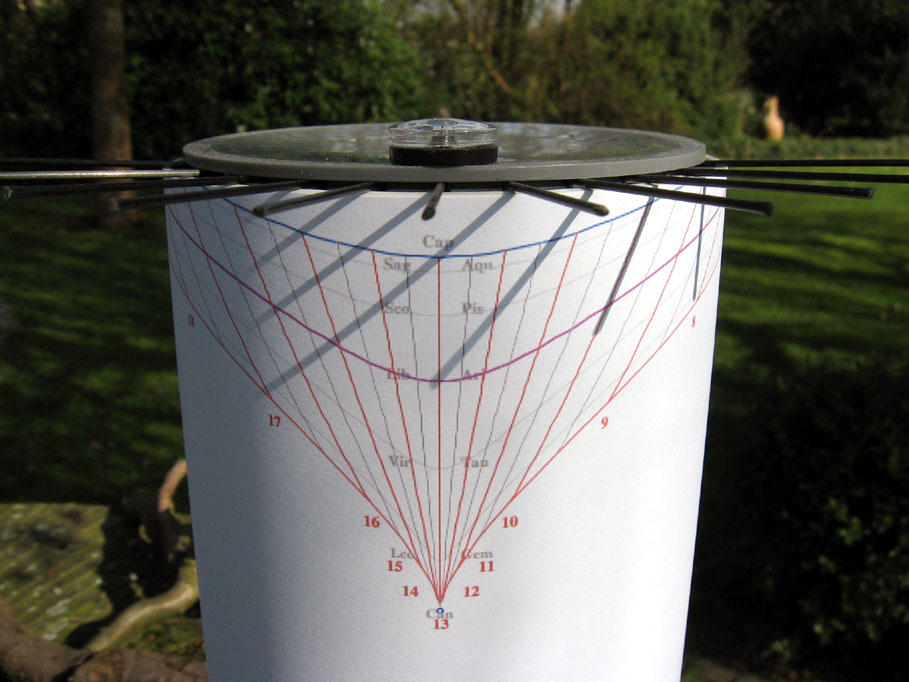
Photo at my home (51.62°N, 7.97°E) on 2010, Apr 07
at 10:30 CEST (2 hours before local solar noon)
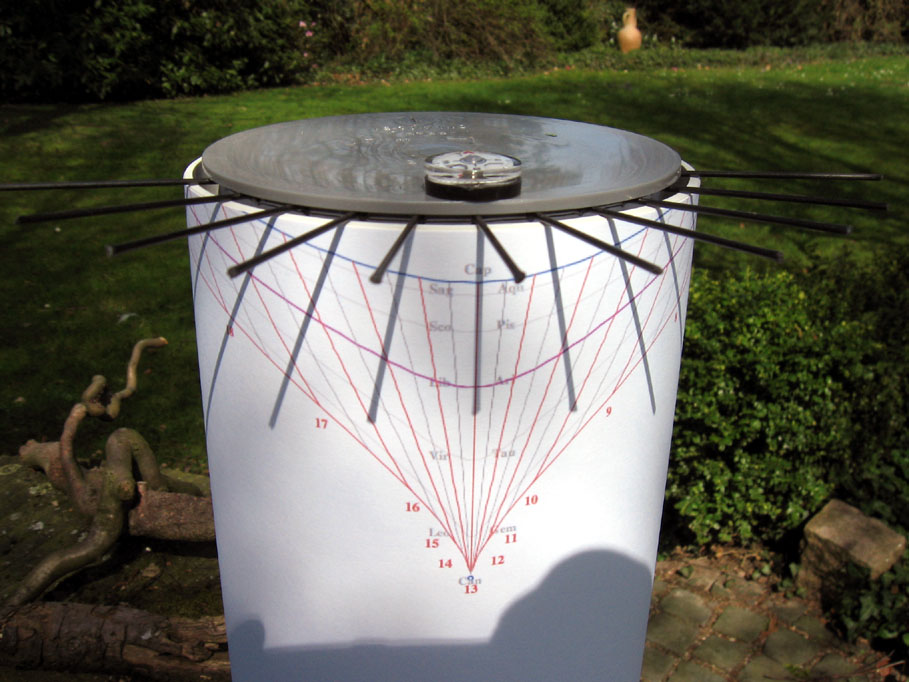
at 13:30 CEST (local solar noon)
Select "Transit Table" from the menu to get the combined corrections for longitude and equation of time.
Copy and paste the content of the window into a text program to print the table.
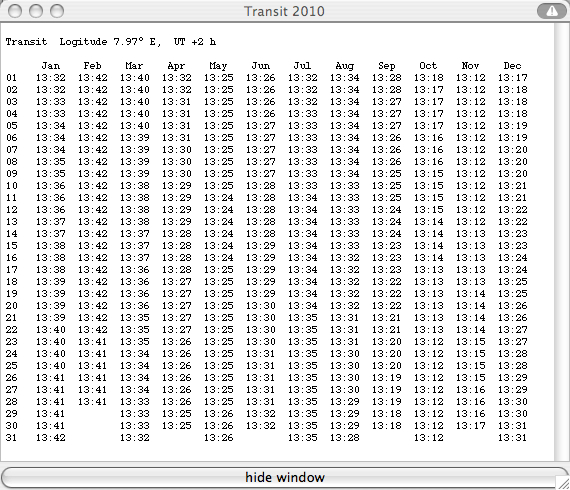
Select "Zodiac Signs Table" from the menu:

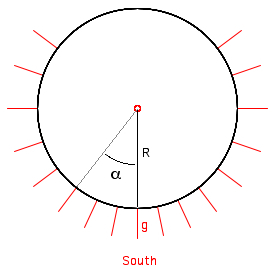 This unique sundial was invented and designed by the French astronomer Alexandre Guy Pingré (1711 - 1796). αn
= sin(latitude)*tan(Hn)
with the hour angle of the Sun Hn=n*15
(n = -8, -7, ..., 7, 8). The gnomon for
H=0 (local noon) is pointing south.Pingré's original sundial (now detached) was mounted on an astrological column (Colonne Médicis) still to be seen in Paris, Rue de Viarmes, in front of the Bourse de Commerce (see texts below). Latitude 48° 52', radius R=154 cm, and 17 gnomons of length g=140 cm. 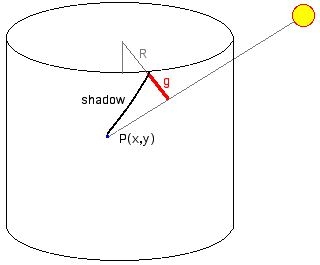 This kind of
a sundial will not be working properly for arbitrary
values of the radius R and the gnomon lenght g.
There may be a hiatus zone.
The hour lines are converging towards the vertical line for noon (12:00). The convergence point will be reached if the gnomon length g g > g1
= R*tan(latitude)*tan(latitude-23.44°).
Example:
for latitude=50.02°, R=6cm, a=3.58 cm 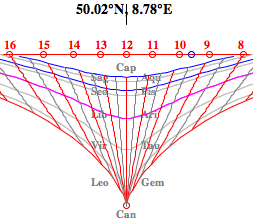 Historical descriptions:
The column erected by Jean
Bullant for Catherine de' Medici at the Hôtel de la
Reine, afterwards the Hôtel de Soissons, and later
the Halles au Blé, which served as an observatory
for her astrologer, has now been built into the
Halles. Originally there was a large ring of metal
round it, on which the hours were shown by a ray of
light passing over them. In the middle of the
eighteenth century the astronomer Pingré drew
lines for two dials upon the column, but none of
these remain.
from: The Book of Sun-dials, by Margaret Scott Gatty (1809-1873), page 168 Catherine de Medicis ...built the famous astrological column (Fig.194). It is still to be seen in Paris. It is the only purely astrological building existing in Eutope. It was built to the design of Pierre Bullant in 1752. It is about a hundred feet high ... ten feet in diameter. At about two thirds of the height there is a sundial ... added under Louis XV by the astronomer Pingre. from Emile Grillot Degivry: Picture Museum of Sorcery, Magic and Alchemy, page 236 An architect and art lover, Laurent Destouches, bought Catherine's 'astrological column' in 1747 for 1,800 livres and somewhat embarrassed, gave it to the city three years later. The city reimbursed him for it, then failed, like everyone else, to figure out what to do with it. Finally it was decided to put a fountain at its base and a sundial on top - which disintegrated completely in 1888. This sundial, designed by Pingré of the Academy of Sciences, required an immense amount of calculations. It was put into service in 1764 and marked the correct time of day on the cylindrical column, in all seasons, but not at night of course. This column is a truly rare thing - constructed by Bullant in 1575, it is about 31 metres high and 3.15 metres in diameter at the base. The interior contains a circular stairway, in stone for the bottom third, and wooden for the rest. There is the door about four metres up - which faced the Queen's apartment - and at the top, and there is a square opening of 65 centimetres a side, each lined up exactly to the major compass points. On top of this there is an elaborate coupole of iron bars, forming interlaced circles and half circles. from The Story of the Hôtel de Soissons In Paris At the foot of the above pillar, the only one of the sort in Paris, is erected a handsome fountain, which furnishes water from the Seine. At two-thirds of its height is a dial of a singular kind, which marks the precise hour at every period of the day, and in all seasons. It is the invention of Father Pingre, who was a regular canon of St. Genevieve, and member of the _ci-devant_ Academy of Sciences. from: Paris as It Was and as It Is, Blagdon, Francis W., 1778-1819. Even of the second palace nothing remains to this day except a fluted column, resting on a fountain, adorned with the arms of Paris, and attached to the exterior of the Halle. This column, erected by Builant in 1572, is said to have been used for the observations of Catherine's astrologer; it now bears a sun-dial, the work of Pingre, canon of St. Geneviève. The Revolution has destroyed the monograms, crescents, fleurs-de-lis, &c., which once adorned it. from: Hare, Augustus J. C. (Augustus John Cuthbert), 1834-1903 |
Cylinder Sundial
More of my sundial applets ...
| Books |
| Savoie, Denis: La
Gnomonique, Les Belles Lettres, Paris 2007. |
|
|
|
Pingre,
Alexandre-Gui (encyclopedia.com) Alexandre Guy
Pingré (Wikipedia) Mémoire sur la Colonne de la Halle aux
Bleds, et sur le Cadran cylindrique que l'on
construit au haut de cette colonne
|
Updated:
2023, Oct 06
©
2010-2023 J. Giesen
![]()



